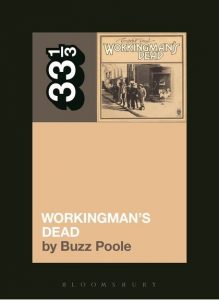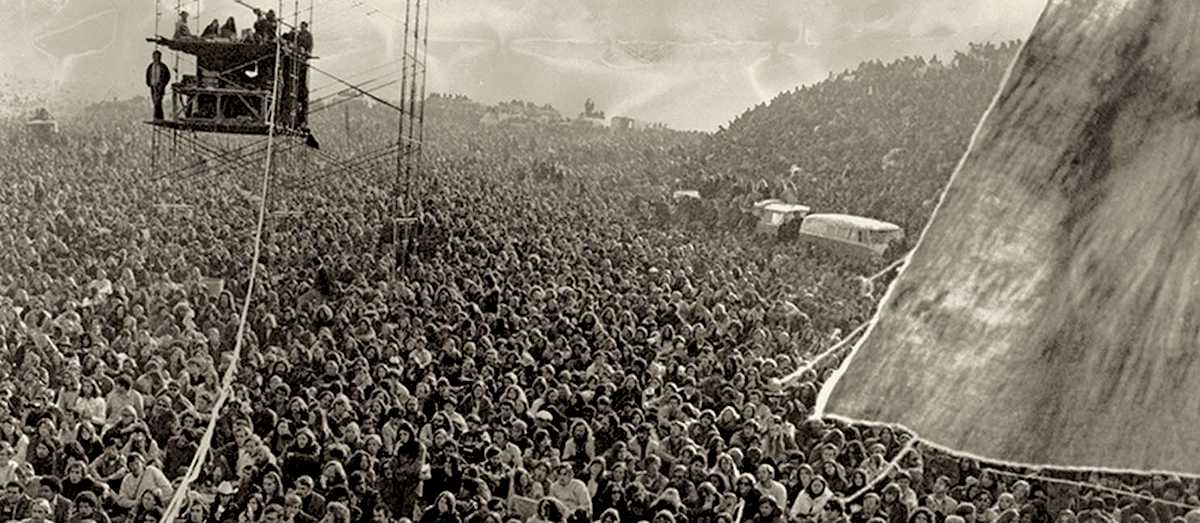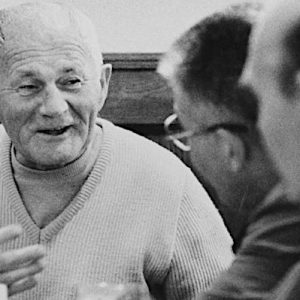Fifty years ago, in December 1969, the groovy 60s came to an end, both literally and figuratively. After events like the Be-In in San Francisco in January 1967, Monterey Pop Festival in June of ’67, and Woodstock in August of ’69, the Altamont Speedway Free Festival signaled how the cultural and political anxieties that lurked in the idealism of the 60s would manifest the uncomfortable realties that came to define the 1970s.
*
Of the eight songs on Workingman’s Dead the origin story for “New Speedway Boogie” is the best known and one of the few explicitly topical songs the Grateful Dead ever recorded. Disinclined to over-explain his work, Robert Hunter, Jerry Garcia’s songwriting partner, never tiptoed around the fact that these lyrics were a response to the events that took place during the Altamont Speedway Free Festival on December 6, 1969: “I was just translating what everyone was saying after Altamont. At that point, I was just trying to be a reporter, almost, in trying to get explicitly what everyone was driving at. Why Altamont was so terrible, and in another way, why it was to be expected.”
Located about 50 miles east of Oakland, the Altamont Speedway was, by Ralph J. Gleason’s reckoning in a piece he penned for Esquire in 1970, “in the crotch of the hills at the southeast end of the Livermore Valley.” On the morning of December 6, it was cold. Around 300,000 people had driven out from the Bay Area on 680 or up from Los Angeles on 5, choking the highways and abandoning their cars on the side of the roads, hoofing it over the sere rain-hungry hills. They had come to see “Woodstock West,” an idea schemed up out of the concerts the Dead and other San Francisco bands had been organizing for years. But this wasn’t a free gig in Golden Gate Park’s Panhandle that had been decided upon that morning. Before the Free Festival was scheduled to begin it was already out of control. The whole reason for throwing together this day of music became public knowledge when, during a televised press conference, Mick Jagger said that the Rolling Stones would be playing a free show in Golden Gate Park to close out their North American tour.
The Dead’s manager, Rock Scully, had hatched the plan during a trip to the UK. He’d gone to London to solidify a free concert in Hyde Park with the Dead, Jefferson Airplane, and Crosby, Stills & Nash. When customs busted him for LSD he had to call on an old friend who introduced him to Sam Cutler, the tour manager for the Stones, who would end up working for the Dead after Altamont. The two of them came up with the idea for a free concert in San Francisco with bands like Santana and Jefferson Airplane on the bill, along with the Dead. The surprise finale would be the Stones, snuck into Golden Gate Park late enough in the day to prevent mayhem. But once Jagger spilled the beans about the biggest rock band in the world playing for free in a city already overrun with Summer of Love refugees, San Francisco refused to let the show go on.
It’s no surprise that Bill Graham, the legendary and cantankerous concert promoter (and one of the Dead’s most rabid champions until his untimely death in a helicopter crash in 1991), wanted no part of the Altamont Free Festival. The potential problems were all too clear to him and he opted out. So Scully and Cutler decided to forge ahead. They searched around frantically for a venue willing to host an event without requiring an enormous financial outlay.
On December 6, the first of many tangible signs that the festival was swerving out of control flared up when Marty Bailin of Jefferson Airplane was knocked out by a Hells Angel when Bailin attempted to stop an Angel from beating up a black audience member right in front of the stage—the stage was very low to the ground and the Angels were paid in beer to work “security.” Garcia compared it to a nice day in hell. In his memoir, bassist Phil Lesh recalls the powerfully weird vibe hovering over Altamont. It was so over the top, the Dead decided not to play, which was another bad decision. “I regret that we didn’t play,” admits Lesh. “[T]he music might have been able to at least modify the rhythm of events in some way, to slow, or even stop, the incessant flood of violence. We’ll never know. In the final analysis, we were afraid to stand up for our belief in the power of music and the spirit of the community . . . Not our finest hour.”
On December 6, the first of many tangible signs that the festival was swerving out of control flared up when Marty Bailin of Jefferson Airplane was knocked out by a Hells Angel.To make matters worse, the Stones were late to take the stage. The story that the band gave for the delay was that bassist Bill Wyman had been held up shopping in San Francisco. That seems to be have been an excuse to justify holding off until the light faded out over the not too distant Pacific Ocean. Another factor that had played into the difficulty of securing a venue was that filmmakers Albert and David Maysles had been touring with the Stones, shooting what would become Gimme Shelter. By the time the Stones took the stage, the lighting made for perfect cinéma vérité, but it was past the point of no return. As Mikal Gilmore wrote in 1990, assessing the legacy of rock ‘n’ roll: “It was a day of legendary violence: The Angels pummeled scores of people, usually with little or no provocation, and in the evening, as the Stones performed ‘Under My Thumb,’ the bikers beat and stabbed a young black man [Meredith Hunter] to death in front of the stage, in full view of the band, the audience members, and a camera crew.”
Altamont made such an impression on the Dead that “New Speedway Boogie” debuted on December 20, 1969, at the Fillmore Auditorium in San Francisco, just two weeks after the Free Festival. It is unsure of itself. The bluesy lope is punctuated by Tom Constanten’s squeaky-hymn organ and the song opens with what would become the final verse: “One way or another / One way or another / One way or another / this darkness got to give.” After several years of hallucinogenic illumination leading the way from one good time to another, darkness had gathered around the band. You can hear Garcia working to remember these newly penned lyrics as Bob Weir sings in forced falsetto and Lesh shout-sings—the Dead’s version of harmonizing. The performance is vocally unserious but instrumentally it marches along, not adventurous but committed. Garcia’s closing “got to give” warbles out as the song ends.
In Hunter’s own words this song was “Written as a reply to an indictment of the Altamont affair by pioneer rock critic Ralph J. Gleason.” Gleason, a tweedy, formidable mover and shaker in the Bay Area music scene had co-founded the Monterey Jazz Festival and counted among his friends the likes of Duke Ellington and Miles Davis. He’d been using his regular column in The San Francisco Chronicle to cover the unfolding debacle. When Jagger announced the free show during the press conference in New York any certainty about the event details crumbled. On November 28, Gleason wrote, “It has really been masterfully mismanaged.” In the days following the concert, Gleason, a bona fide supporter of the Dead, became increasingly critical of how the situation was being handled.
When San Francisco refused to host the festival Scully and Cutler tried to book Sears Point Raceway in Sonoma County and when that didn’t pan out they settled on Altamont. Gleason explained to his readers how the venue problems resulted from the various organizing parties’ inability to agree on the distribution of any revenue generated by film and television broadcast rights (further confused by the presence of the Maysles). The San Francisco Mime Troupe had publicly demanded that any profits be put toward the Weathermen Defense Fund. In the concert’s aftermath everyone was trying to finger point and wash the blood off their hands. Gleason’s wrath intensified.
There was the attention-grabbing December 18 headline “Who’s Responsible for the Murder?” Gleason was infuriated by the shell game of responsibility being hustled by the Stones who were laying blame on the Dead camp while also being evasive about financially compensating the family of Meredith Hunter, even though each of the Stones earned around $425,000 for the fiasco. On December 12, Gleason declared, “But the saddest thing about it all, re-enforcing my conviction that none of these people are real in a sense.”
Gleason was onto something here. The Grateful Dead and the Rolling Stones, and the Beatles for that matter, along with individuals like Bob Dylan and Jimi Hendrix, had been propped up by a culture to be understood as representing that culture, involving their public personas in any range of issues that had little to do with music. During his tenure as the Dead’s publicist, Dennis McNally often had to deal with how “the inertia of media—the received stereotype image of the sixties, of what hippie was supposed to mean” trailed the band from 1970 on. This inertia resulted in journalists and film crews doing stories that they’d already put together in their heads before doing any actual reporting. The rebellion associated with rock ‘n’ roll from its inception had morphed into something greater than its reality. Woodstock had solidified the dominant media narrative about the counterculture as a story of peace and love, of unity, of undying respect for all brothers and sisters. But there were plenty of counterculture factions, and friction between them, especially in the differences between the West Coast and the rest of the country.
The Grateful Dead and the Rolling Stones, and the Beatles for that matter, had been propped up by a culture to be understood as representing that culture, involving their public personas in any range of issues that had little to do with music.Although the music sounded very different, MC5, The Stooges, and Velvet Underground were voicing their own antiestablishment sentiments, “making plain that underneath the veneer of altruism and idealism, the 1960s youth scene was riddled with some considerably darker truths, namely, that drugs had quickly become as much a means to obliterate as to enlighten, and that in a truly free or anarchistic society, bloodshed was as likely to be encountered as lasting peace or equality.” The Velvet Underground made no secret about how much they detested hippies and California. Mo Tucker said, “We really hated all of the West Coast bands”; John Cale referred to their attitude toward the West Coast as “one of hatred and derision.” Talking in particular about the San Francisco scene, Lou Reed did not hold back, insisting, “It’s just tedious, a lie, and untalented. They can’t play and the certainly can’t write . . . People like the Jefferson Airplane and the Grateful Dead are the most untalented bores that ever came up.”
Presumably to the Velvets’ chagrin, they shared two bills with the Dead in 1969, in February at the Stanley Theatre in Pittsburgh and in Chicago the following April at the Kinetic Playground. No matter how the bands felt about it, being booked for the same gigs demonstrates how promoters and concertgoers understood both as products of the same moment in time. In reviewing a book about the Velvets, Mark Greif points out that the two bands shared several similarities. “[L]like the Grateful Dead, the Velvet Underground started out as a platform for extremely long, wandering, repetitive, live improvisations, appropriate to multimedia events.” And then there is the fact that when both bands first formed they took the name “Warlocks,” “essentially because each had a vision of enchantment, underlaid with darkness.”
The way the two bands differed was in how they made their fans feel. Greif cites a story about how Bill Graham banned the Velvet Underground from the Fillmore West after they ended their show by leaning their plugged in instruments against the speakers on stage, unleashing ferocious feedback. (Another version of the story has it that Reed destroyed Tucker’s drum kit at the end of the show just to spite Graham.) Either way, the Velvets made noise in the name of conjuring anger and discomfort.
The Dead regularly utilized feedback as a mode of musical exploration and Graham loved the Dead; he had no objection to music being noisy. What he did not like, however, was how the Velvets’ music assaulted the audience, hurt their ears, and intentionally made them uncomfortable. For the Velvets malignant music made a broader point about culture at large. Life was not all fun and games, which is how they believed the West Coast saw things. Life was hard and painful and rather than use drugs to escape these truths, they were going to rip you from your blissed out revelry and attack you.
For the Velvets malignant music made a broader point about culture at large. Life was not all fun and games, which is how they believed the West Coast saw things.But the Dead and the Velvets were the same in that they were outsiders calling attention to everything that they identified as wrong. “It’s hard to run with the weight of gold / Other hand I heard it said / it’s just as hard with the weight of lead.” The burden of that weight is the same; a ton of gold weighs the same as a ton of lead. This perspective reflects the holistic nature of all the songs on Workingman’s Dead and how the divisions that do exist, whether political or cultural, should not be seen as polarizing but as parts of the whole that none of us can escape. As Garcia said, looking back on Altamont: “There’s darkness and light and it’s the interplay that represents the game we’re allowed to play on this planet. Just the fact that there are two opposing elements in the universe is the grace of the cosmic game. . . . You know, you get to be whole, as whole as you conceive yourself to be, but you have to be able to look at every event and not turn from any one.”
Altamont did solidify for the Dead the idea that their role as musicians was becoming complicated by factors out of their control. As their popularity grew and the scene around them expanded they had no choice, short of not making music, but to think about what was happening around them. “New Speedway Boogie” winds down with the verse “I don’t know but I been told / if the horse don’t pull you got to carry the load / I don’t know whose back’s that strong / Maybe find out before too long.” The horse is the cultural momentum the Dead enjoyed between 1965 and 1969. But that horse was no longer going to pull, forcing the Dead to carry the load, hoping those around them would do the same. It is a harrowing proposition. The load was heavy. So heavy that perhaps no one’s back was strong enough to take on the burden. Only time would tell.
_____________________________________

Adapted from the “New Speedway Boogie” chapter of Workingman’s Dead, published as part of the “33 1/3” series from Bloomsbury. Used with permission of the publisher. Copyright 2016 by Buzz Poole.


